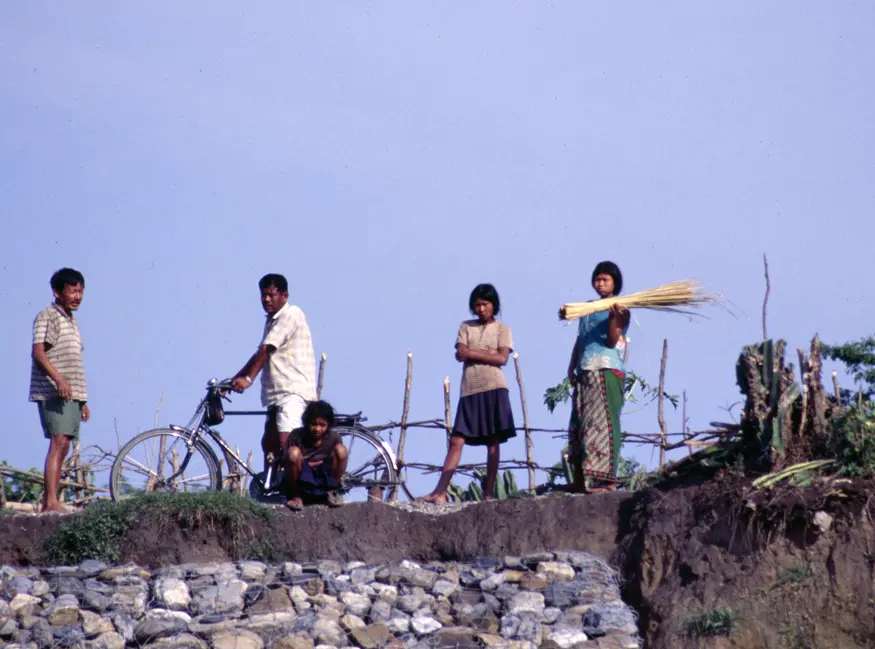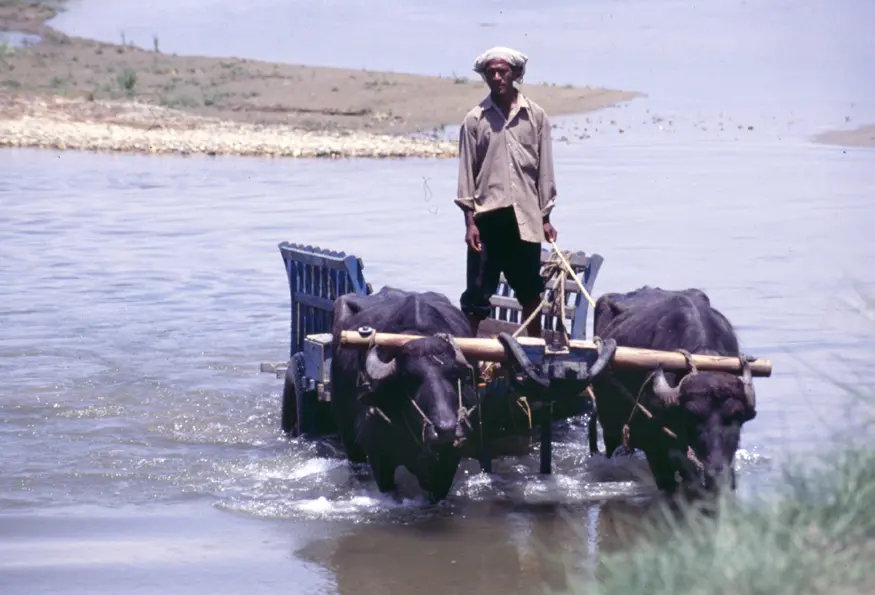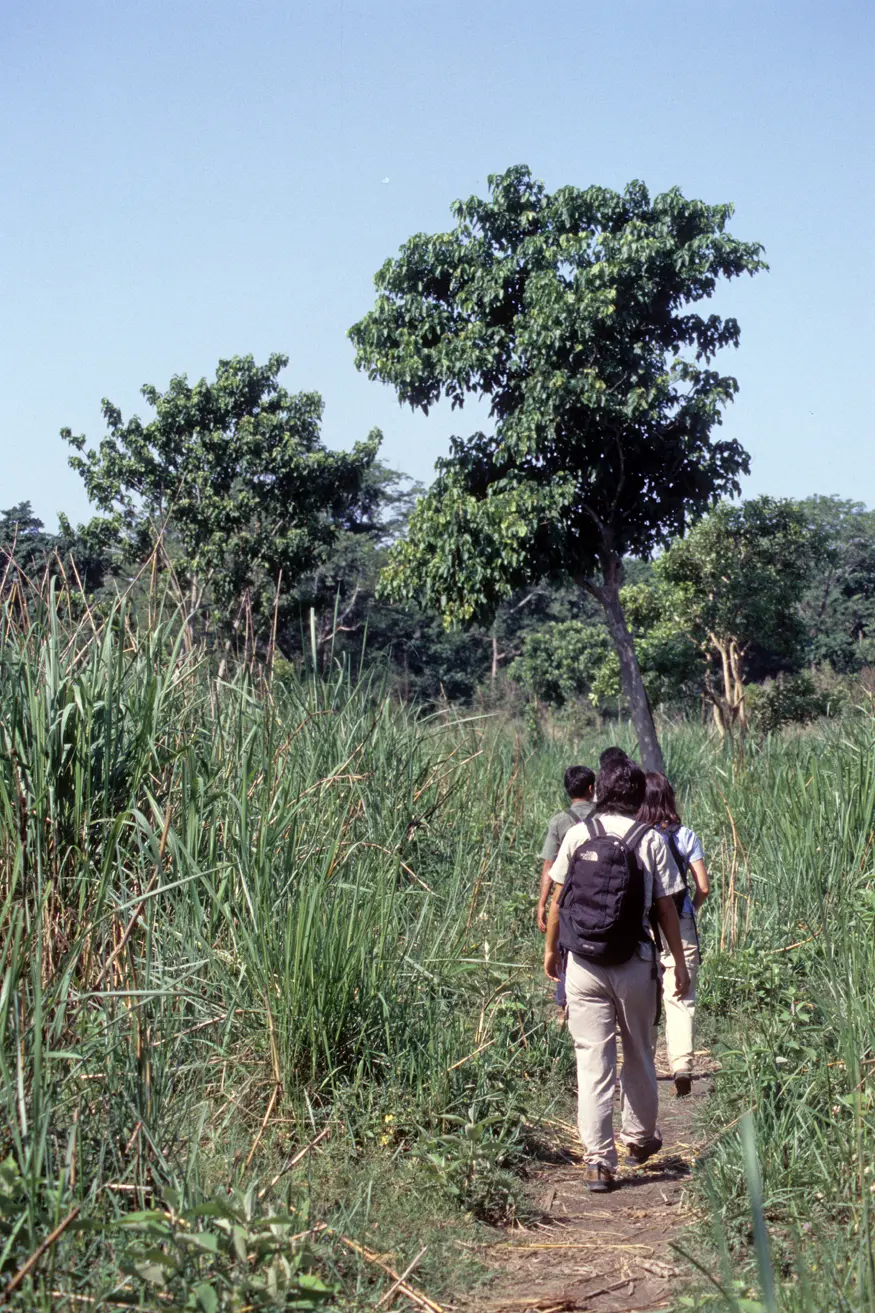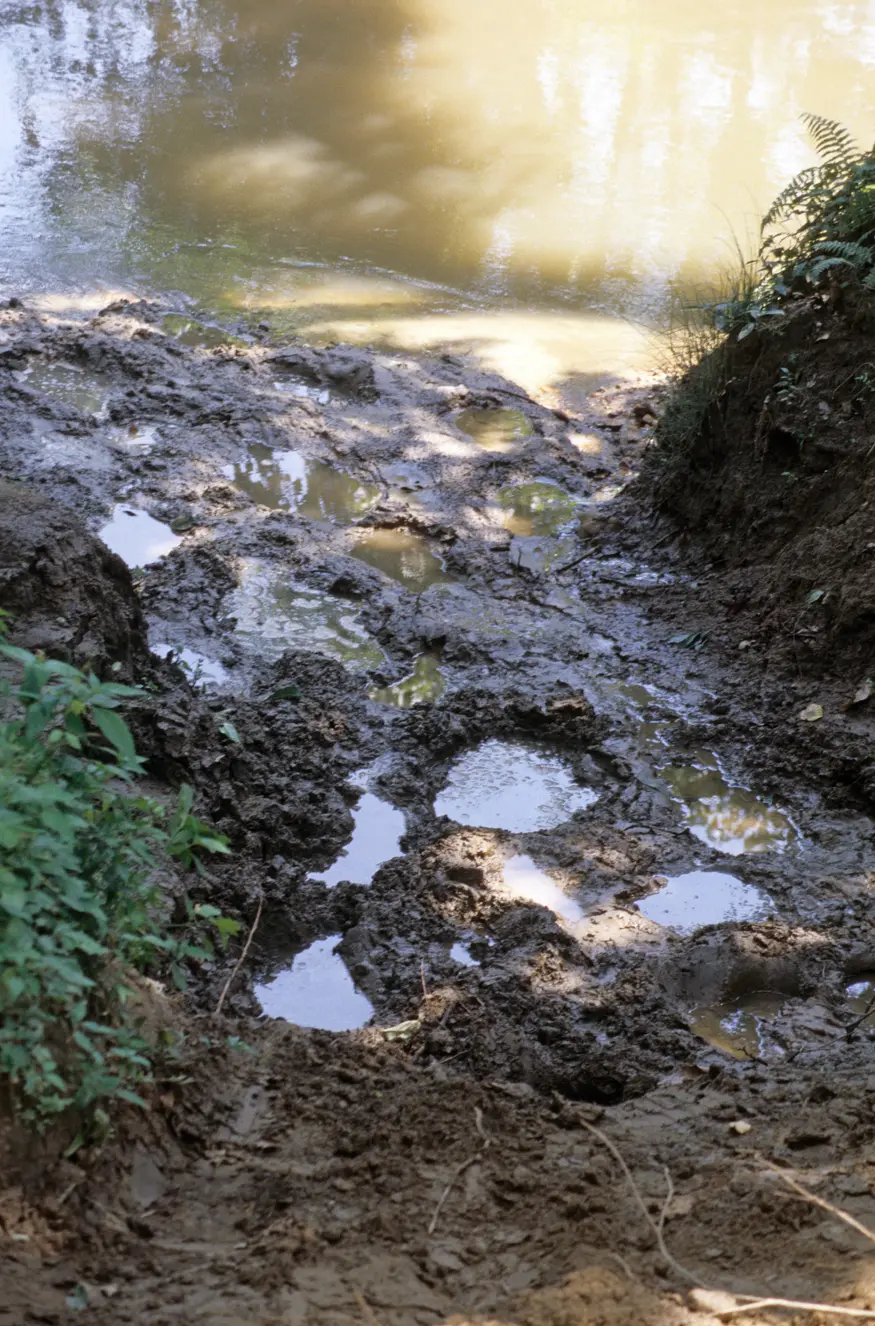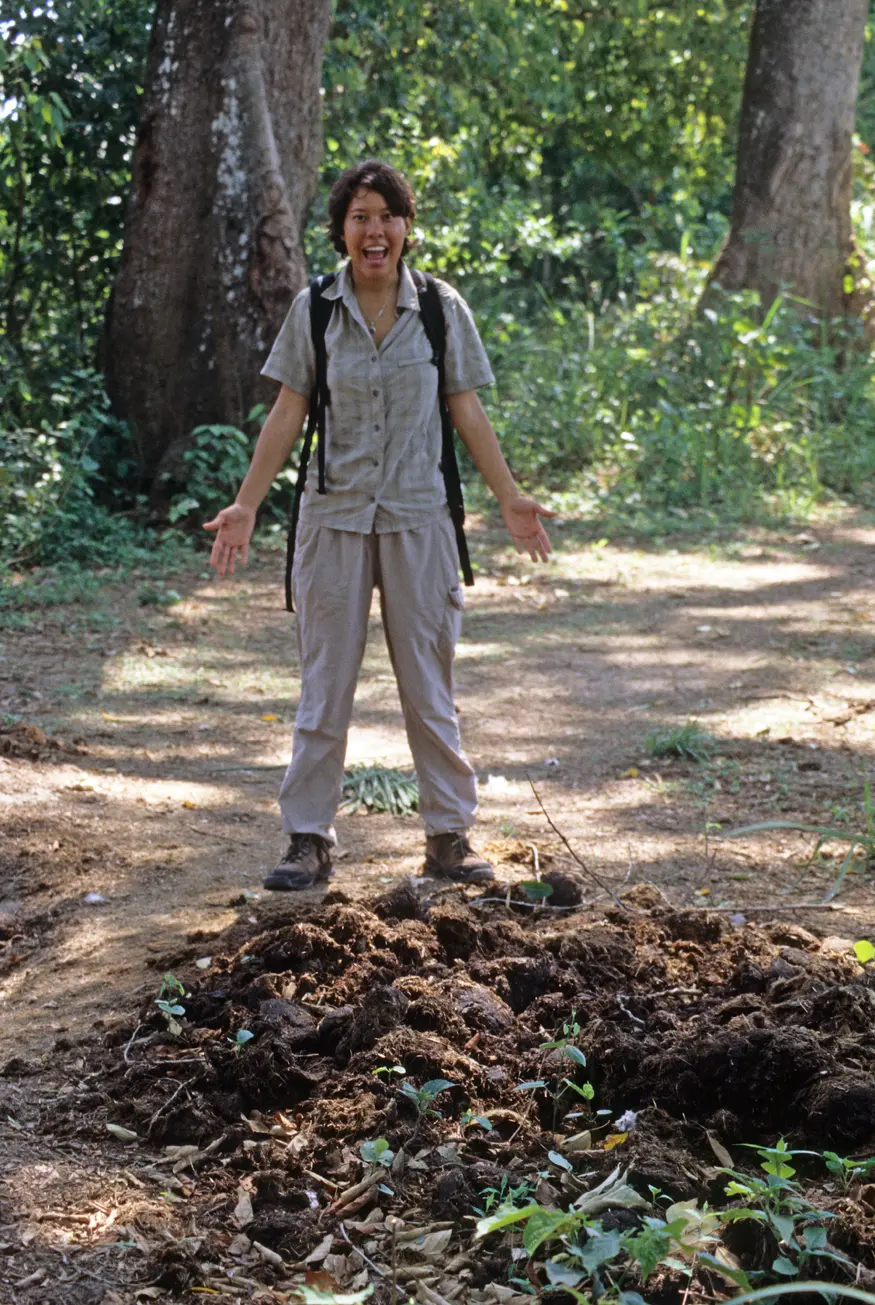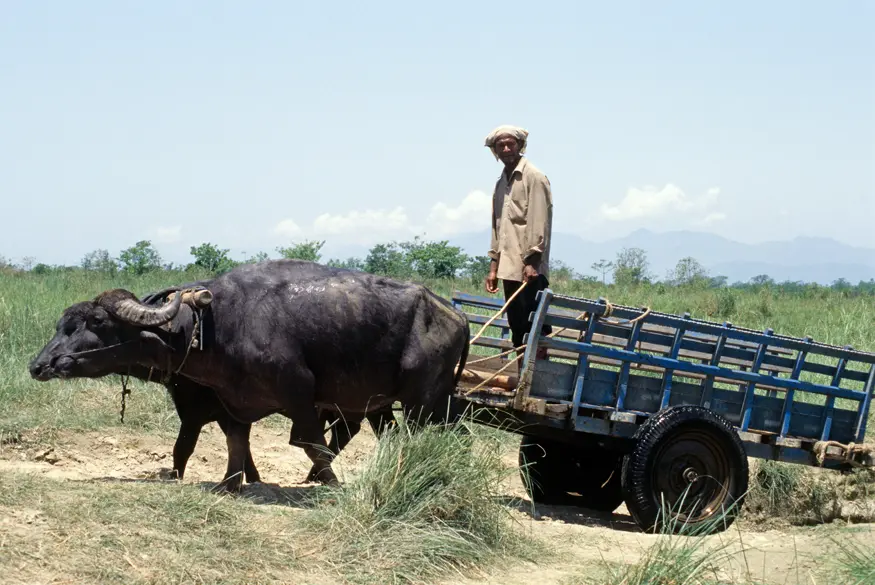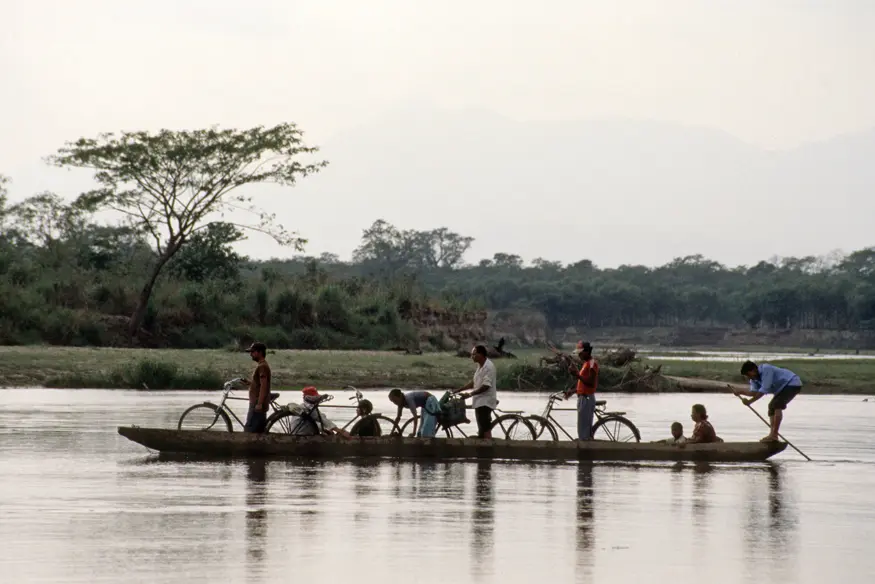Post from Michelle:
Royal Chitwan National Park lies close to the border of India, in a subtropical plain. Home to rhinoceros, tigers, sloth bears, monkeys, deer, and over 450 types of birds, it is a superb place to view wildlife. On our first morning visiting the park we decided to take a canoe ride into the park and from there, walk through the jungle on a guided trek. Walking through the jungle is not particularly safe, but it is the most exciting way to see the wildlife up close.
Floating down the river in a dug-out canoe offered a front row seat to the bird life: white egrets stood gracefully on the water's edge, a huge stork (the largest I have ever seen) stood in a small cove eating in seclusion, a rust colored duck dunked happily, kingfishers sang along the shore while sandpipers peered out of their nests, holes in the sandy river bank. The variety and multitude of birds was amazing.
Forty minutes down stream the canoe hit the shore with a thud and our two guides jumped out. Immediately they both started jumping up and down in frantic motions - I thought is must be a strange Nepalese ritual dance asking the gods for protection before entering the jungle. But then I understood their funny movements when I saw a snake slithering between their unprotected flip-flopped feet and escaping into the river. Welcome to the jungle.
We walked across a sandy area and entered woods. The guides stopped to give us brief "survival" lessons:
Lesson 1: Rhinos have terrible eyesight but have keen senses of smell and hearing. Their bad eyesight makes them vulnerable so they compensate by charging when they sense danger. So upon sighting a rhino, climb the nearest tree, scaling at least eight feet off the ground. If there are no trees, throw your backpack to the ground to cause a distraction and then run in a zigzag line (rhinos have a hard time turning their large bodies quickly). As if that wasn't enough to make me cautious, the guide informed us it was rhino mating season and the male rhinos are much more aggressive than usual. In fact, a Nepalese student had been killed the previous month by a charging rhino.
Lesson 2: Sloth bears can be extremely aggressive. When encountering a sloth bear gather in a close group and start yelling and waving your arms, pretending to be one large foe. Both our guides carried large intimidating sticks to defend the group in case of an attack. Later, they admitted of all the animals in the park, they most feared the bear.
Lesson 3: Tigers hunt by night and would be a rare sight. If one did attack, there is not much we could do about it, so try not to worry. Very comforting.
None of these lessons made me feel particularly good about our walk but now there was no turning back. We were in the heart of the jungle, far from any roads. Lessons over, we began our trek. Every tree I passed I wondered if I could climb. As a kid I climbed many trees, but that was decades ago and I am not so confident in my climbing abilities now. The best time to perfect rusty skills is not when a rhino is charging, but it is a good inspiration to try.
A couple meters later the branches overhead began crashing and swaying. Gray Langur monkeys jumped through treetops, fleeing from our intruding group. Soon we passed wild chickens and then barking deer in a small clearing. Barking deer are quite small and bark like a dog when alarmed. The amount of wildlife we saw in ten minutes of walking amazed me.
Our group left the wooded area and entered grassland scattered with small trees. The elephant grass, taller than our heads, surrounded us and made it impossible to see more than a couple meters in any direction. As we followed a dirt trail the thought we must be crazy to walk in the midst of wild animals crossed my mind several times and I gave Tim stern glances to communicate this. Careful not to make too much noise we talked in whispers and made our steps as light as possible. The temperature was scorching hot and the humidity so thick I could swim in it. Sweat dripped off our noses and down our backs.
Suddenly, both guides stopped and motioned us to stand still. My body froze and so did my heart. Not far ahead two rhinos grazed. I could see the big round behind of the closest rhino and watched as it slowly turned toward us. The guides made quick upward hand movements signaling us to climb a tree and at lightning speed I quickly scaled the nearest tree, my heart beating so hard I was sure it would break through my chest. High off the ground I had a clear view of the closest rhino. It was a magnificent creature with gray thick skin resembling layered metal armour.
It's ears perked forward and it's nostrils widened, taking in deep breaths of human and absorbing our presence. Tim was still looking for a tree to climb when the rhino began running and let out a thunderous roar. I screamed and could only breathe again when Tim was safely high in a tree and the rhino had passed. We waited in our trees for what seemed a very short time when the guides told us to climb down. I think I could have stayed up there all day. I hugged the tree, thanking it for being there for me when I need it and descended. It took all my courage to begin walking again for the last few minutes had been some of the most frightening in my life. Only four more hours of walking left!
The rest of the walk was comparatively uneventful. Thankfully, we had no more live rhino encounters but saw lots of evidence of their proximity - huge fresh heaps of rhino dung, deposited to mark their territory greeted us often and their immense footprints in the soft mud reminded us to remain alert. By lunchtime we were safely back in town and I was never so glad to see civilization. People eating at outdoor restaurants, motorbikes, and souvenir shops insured me there were no charging rhinos around - besides, there weren't any good trees to climb.
Floating down the river in a dug-out canoe offered a front row seat to the bird life: white egrets stood gracefully on the water's edge, a huge stork (the largest I have ever seen) stood in a small cove eating in seclusion, a rust colored duck dunked happily, kingfishers sang along the shore while sandpipers peered out of their nests, holes in the sandy river bank. The variety and multitude of birds was amazing.
Forty minutes down stream the canoe hit the shore with a thud and our two guides jumped out. Immediately they both started jumping up and down in frantic motions - I thought is must be a strange Nepalese ritual dance asking the gods for protection before entering the jungle. But then I understood their funny movements when I saw a snake slithering between their unprotected flip-flopped feet and escaping into the river. Welcome to the jungle.
We walked across a sandy area and entered woods. The guides stopped to give us brief "survival" lessons:
Lesson 1: Rhinos have terrible eyesight but have keen senses of smell and hearing. Their bad eyesight makes them vulnerable so they compensate by charging when they sense danger. So upon sighting a rhino, climb the nearest tree, scaling at least eight feet off the ground. If there are no trees, throw your backpack to the ground to cause a distraction and then run in a zigzag line (rhinos have a hard time turning their large bodies quickly). As if that wasn't enough to make me cautious, the guide informed us it was rhino mating season and the male rhinos are much more aggressive than usual. In fact, a Nepalese student had been killed the previous month by a charging rhino.
Lesson 2: Sloth bears can be extremely aggressive. When encountering a sloth bear gather in a close group and start yelling and waving your arms, pretending to be one large foe. Both our guides carried large intimidating sticks to defend the group in case of an attack. Later, they admitted of all the animals in the park, they most feared the bear.
Lesson 3: Tigers hunt by night and would be a rare sight. If one did attack, there is not much we could do about it, so try not to worry. Very comforting.
None of these lessons made me feel particularly good about our walk but now there was no turning back. We were in the heart of the jungle, far from any roads. Lessons over, we began our trek. Every tree I passed I wondered if I could climb. As a kid I climbed many trees, but that was decades ago and I am not so confident in my climbing abilities now. The best time to perfect rusty skills is not when a rhino is charging, but it is a good inspiration to try.
A couple meters later the branches overhead began crashing and swaying. Gray Langur monkeys jumped through treetops, fleeing from our intruding group. Soon we passed wild chickens and then barking deer in a small clearing. Barking deer are quite small and bark like a dog when alarmed. The amount of wildlife we saw in ten minutes of walking amazed me.
Our group left the wooded area and entered grassland scattered with small trees. The elephant grass, taller than our heads, surrounded us and made it impossible to see more than a couple meters in any direction. As we followed a dirt trail the thought we must be crazy to walk in the midst of wild animals crossed my mind several times and I gave Tim stern glances to communicate this. Careful not to make too much noise we talked in whispers and made our steps as light as possible. The temperature was scorching hot and the humidity so thick I could swim in it. Sweat dripped off our noses and down our backs.
Suddenly, both guides stopped and motioned us to stand still. My body froze and so did my heart. Not far ahead two rhinos grazed. I could see the big round behind of the closest rhino and watched as it slowly turned toward us. The guides made quick upward hand movements signaling us to climb a tree and at lightning speed I quickly scaled the nearest tree, my heart beating so hard I was sure it would break through my chest. High off the ground I had a clear view of the closest rhino. It was a magnificent creature with gray thick skin resembling layered metal armour.
It's ears perked forward and it's nostrils widened, taking in deep breaths of human and absorbing our presence. Tim was still looking for a tree to climb when the rhino began running and let out a thunderous roar. I screamed and could only breathe again when Tim was safely high in a tree and the rhino had passed. We waited in our trees for what seemed a very short time when the guides told us to climb down. I think I could have stayed up there all day. I hugged the tree, thanking it for being there for me when I need it and descended. It took all my courage to begin walking again for the last few minutes had been some of the most frightening in my life. Only four more hours of walking left!
The rest of the walk was comparatively uneventful. Thankfully, we had no more live rhino encounters but saw lots of evidence of their proximity - huge fresh heaps of rhino dung, deposited to mark their territory greeted us often and their immense footprints in the soft mud reminded us to remain alert. By lunchtime we were safely back in town and I was never so glad to see civilization. People eating at outdoor restaurants, motorbikes, and souvenir shops insured me there were no charging rhinos around - besides, there weren't any good trees to climb.
Photos From This Location

